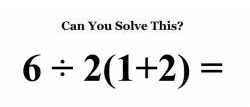[133 / 21 / 65]
Quoted By: >>15231880 >>15231881 >>15231882 >>15231884 >>15231890 >>15231895 >>15231898 >>15231903 >>15231908 >>15231909 >>15231913 >>15231915 >>15231925 >>15231926 >>15231934 >>15231935 >>15231936 >>15231937 >>15231940 >>15231942 >>15231943 >>15231944 >>15231949 >>15231958 >>15231960 >>15231973 >>15231979 >>15231983 >>15231993 >>15231996 >>15231999 >>15232000 >>15232030
Listen here fags, I'm going to end this discussion to fucking end these retarded post once and for all.
First thing, FUCK PEMDAS, the order in which you calculate DOES NOT MATTER, just don't do retarded shit like multiplying denominators with numerators.
I'll now proceed to calculate the equation in different ways:
6 ÷ 2 (1 + 2) = 6 ÷ 2 (3) = 18 ÷ 2 = 9
6 ÷ 2 (1 + 2) = 6 ÷ 2 (3) = 3 (3) = 9
6 ÷ 2 (1 + 2) = (6 + 12) ÷ 2 = 18 ÷ 2 = 9
6 ÷ 2 (1 + 2) = (6 + 12) ÷ 2 = 3 + 6 = 9
6 ÷ 2 (1 + 2) = 3 (1 + 2) = 3 + 6 = 9
6 ÷ 2 (1 + 2) = 3 (1 + 2) = 3 (3) = 9 etc....
Now you might ask "but anon you multiplied the 3 with the 6 instead of the 2 on your first calculation, why?"
Because you DO NOT MULTIPLY NUMERATORS WITH DENOMINATORS. When you have the ÷ sign, the number that comes before it (the one being divided) is the numerator and the number that comes after is the denominator.
In this case, 6 is the numerator while 2 is the denominator. Any number outside the division is a numerator because they are effectively always being divided by 1, i.e.:
6 ÷ 2 (1 + 2) = 6 ÷ 2 (1 + 2) ÷ 1
or
6 ÷ 2 (1 + 2) = 6 ÷ 2 (3) = 6 ÷ 2 (3) ÷ 1
In the first division we have numerator = 6 and denominator = 2, while in the second one we have numerator = (1 + 2) and denominator = 1 or if you calculate the parenthesis first we have numerator = 3 and denominator = 1
Multiplying numerator with numerator and denominator with denominator we get:
6 ÷ 2 (1 + 2) ÷ 1 = (6 + 12) ÷ 2 = 18 ÷ 2 = 9
or
6 ÷ 2 (3) ÷ 1 = 18 ÷ 2 = 9
First thing, FUCK PEMDAS, the order in which you calculate DOES NOT MATTER, just don't do retarded shit like multiplying denominators with numerators.
I'll now proceed to calculate the equation in different ways:
6 ÷ 2 (1 + 2) = 6 ÷ 2 (3) = 18 ÷ 2 = 9
6 ÷ 2 (1 + 2) = 6 ÷ 2 (3) = 3 (3) = 9
6 ÷ 2 (1 + 2) = (6 + 12) ÷ 2 = 18 ÷ 2 = 9
6 ÷ 2 (1 + 2) = (6 + 12) ÷ 2 = 3 + 6 = 9
6 ÷ 2 (1 + 2) = 3 (1 + 2) = 3 + 6 = 9
6 ÷ 2 (1 + 2) = 3 (1 + 2) = 3 (3) = 9 etc....
Now you might ask "but anon you multiplied the 3 with the 6 instead of the 2 on your first calculation, why?"
Because you DO NOT MULTIPLY NUMERATORS WITH DENOMINATORS. When you have the ÷ sign, the number that comes before it (the one being divided) is the numerator and the number that comes after is the denominator.
In this case, 6 is the numerator while 2 is the denominator. Any number outside the division is a numerator because they are effectively always being divided by 1, i.e.:
6 ÷ 2 (1 + 2) = 6 ÷ 2 (1 + 2) ÷ 1
or
6 ÷ 2 (1 + 2) = 6 ÷ 2 (3) = 6 ÷ 2 (3) ÷ 1
In the first division we have numerator = 6 and denominator = 2, while in the second one we have numerator = (1 + 2) and denominator = 1 or if you calculate the parenthesis first we have numerator = 3 and denominator = 1
Multiplying numerator with numerator and denominator with denominator we get:
6 ÷ 2 (1 + 2) ÷ 1 = (6 + 12) ÷ 2 = 18 ÷ 2 = 9
or
6 ÷ 2 (3) ÷ 1 = 18 ÷ 2 = 9

